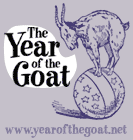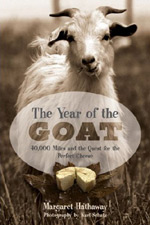Al, an exquisite landscape painter who by day works with Bill at the Navajo Housing Authority, grew up on a Navajo reservation and was raised with goats, but the world of show goats was entirely new to him. It's one that he's taken to, and his affection for the La Manchas is clear. Unlike the angoras that are generally raised among Native Americans for their meat and hair, La Manchas are prized for their milk and their sweet, docile temperament. Their feed is carefully regulated and their grooming schedule is strict. Their milk production is monitored, and though in the Matrix herd they're milked only once a day, their volume of production is high.
Since we were visiting during evening chores, Karl and I got a chance to experience the milking first hand. Though we'd visited many dairy breeders, Bill and Al were the first to offer us a milking lesson. Explaining how to squeeze the teat, and how the udder would soften as though it were deflating, they chose their mellowest animals and let us take turns at the milking stand. The men and their does were very patient with us, even as the milk missed the bucket, climbed up our wrists, and once showered Al's nephew, Cory, with a foamy white mist. Suffice to say, we weren't naturals.
We were enthusiastic, though, and the experience was phenomenal. Though we were total amateurs and both times needed Bill to take over and finish the job (milking is much harder work, and uses much stranger muscles, than we'd imagined), it felt very rewarding to squeeze even one drop of milk into the bucket. Touching the animals felt surprisingly intimate, and I understood in a different way the connection dairy breeders have to their does. The experience was humbling because it totally changed our perspective on dairy goats and reminded us, yet again, how much we have left to learn. —MMH




